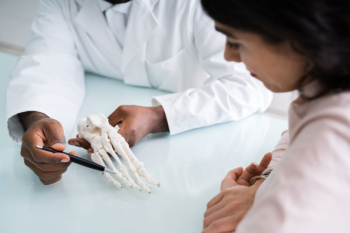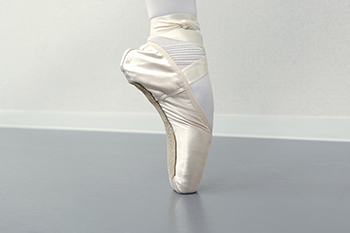Connect With Us
Blog
Items filtered by date: August 2024
Wounds That Don't Heal Need to Be Checked
How a Podiatrist Can Help You

A podiatrist is a medical specialist focused on diagnosing and treating conditions related to the feet, ankles, and lower legs. These professionals are trained to handle a wide range of issues, from common problems like bunions and heel pain to more complex conditions such as fractures, diabetic foot care, and toe deformities. Visiting a podiatrist offers several benefits. They provide expert evaluations and tailored treatment plans for various foot and ankle concerns, ensuring accurate diagnoses and effective management. Podiatrists are skilled in performing surgeries, prescribing medications, and recommending targeted exercises to alleviate pain and improve mobility. They also offer preventive care and education to help avoid future problems. For those individuals with chronic conditions, such as diabetes, a podiatrist plays an important role in preventing complications by regularly monitoring foot health and providing specialized care. If you have any foot issues, it is suggested you schedule an appointment with a podiatrist who provides comprehensive, specialized treatment to maintain optimal foot and ankle health.
If you are experiencing pain in the feet or ankles, don’t join the stubborn majority refusing treatment. Feel free to contact Jeffrey L. Bober, DPM from Maryland. Our doctor can provide the care you need to keep you pain-free and on your feet.
What Is a Podiatrist?
Someone would seek the care of a podiatrist if they have suffered a foot injury or have common foot ailments such as heal spurs, bunions, arch problems, deformities, ingrown toenails, corns, foot and ankle problems, etc.
Podiatric Treatment
A podiatrist will treat the problematic areas of the feet, ankle or lower leg by prescribing the following:
- Physical therapy
- Drugs
- Orthotic inserts or soles
- Surgery on lower extremity fractures
A common podiatric procedure a podiatrist will use is a scanner or force plate which will allow the podiatrist to know the designs of orthotics. Patients are then told to follow a series of tasks to complete the treatment. The computer will scan the foot a see which areas show weight distribution and pressure points. The podiatrist will read the analysis and then determine which treatment plans are available.
If you have any questions please feel free to contact our office located in Glen Burnie, MD . We offer the newest diagnostic and treatment technologies for all your foot and ankle needs.
How Diabetes Can Affect Feet

Diabetes can significantly impact foot health due to reduced blood circulation and nerve damage, which is known as neuropathy. Poor circulation hampers the delivery of oxygen and nutrients, slowing wound healing and increasing infection risk. Neuropathy diminishes sensation, making it difficult to detect injuries or pressure points, leading to untreated wounds. Proper foot care is essential for individuals with diabetes. Daily inspections for cuts, blisters, or swelling, keeping feet clean and moisturized, and wearing properly fitting shoes are key steps. If you have diabetes, it is suggested that you schedule regular visits to a podiatrist who can monitor foot health, treat issues early, and provide guidance on preventive care.
Diabetic foot care is important in preventing foot ailments such as ulcers. If you are suffering from diabetes or have any other concerns about your feet, contact Jeffrey L. Bober, DPM from Maryland. Our doctor can provide the care you need to keep you pain-free and on your feet.
Diabetic Foot Care
Diabetes affects millions of people every year. The condition can damage blood vessels in many parts of the body, especially the feet. Because of this, taking care of your feet is essential if you have diabetes, and having a podiatrist help monitor your foot health is highly recommended.
The Importance of Caring for Your Feet
- Routinely inspect your feet for bruises or sores.
- Wear socks that fit your feet comfortably.
- Wear comfortable shoes that provide adequate support.
Patients with diabetes should have their doctor monitor their blood levels, as blood sugar levels play such a huge role in diabetic care. Monitoring these levels on a regular basis is highly advised.
It is always best to inform your healthcare professional of any concerns you may have regarding your feet, especially for diabetic patients. Early treatment and routine foot examinations are keys to maintaining proper health, especially because severe complications can arise if proper treatment is not applied.
If you have any questions please feel free to contact our office located in Glen Burnie, MD . We offer the newest diagnostic and treatment technologies for all your foot and ankle needs.
How Foot Bones Work Together in Ballet

In ballet, the coordination of foot bones is essential for achieving fluid and graceful movements. During a tendu, the foot extends and stretches, with the bones and tendons working together to create a smooth, elongated line. A plié involves bending the knees while keeping the feet firmly grounded, requiring precise articulation of the ankle and foot bones to maintain balance and control. Port-de-bras, the movement of the arms in coordination with the feet, enhances overall fluidity and expression. Effective foot and ankle articulation involves strengthening the muscles and tendons surrounding these areas to ensure flexibility and stability. Proper technique and consistent practice help ballet dancers achieve aesthetic, elegant movements and avoid injury through careful, controlled use of the foot bones and surrounding structures. If you are a ballet dancer, and have injured your foot or ankle, it is suggested that you consult a podiatrist who can provide treatment and guide you on how to perform specific stretches for optimal results.
If you have any concerns about your feet, contact Jeffrey L. Bober, DPM from Maryland. Our doctor can provide the care you need to keep you pain-free and on your feet.
Biomechanics in Podiatry
Podiatric biomechanics is a particular sector of specialty podiatry with licensed practitioners who are trained to diagnose and treat conditions affecting the foot, ankle and lower leg. Biomechanics deals with the forces that act against the body, causing an interference with the biological structures. It focuses on the movement of the ankle, the foot and the forces that interact with them.
A History of Biomechanics
- Biomechanics dates back to the BC era in Egypt where evidence of professional foot care has been recorded.
- In 1974, biomechanics gained a higher profile from the studies of Merton Root, who claimed that by changing or controlling the forces between the ankle and the foot, corrections or conditions could be implemented to gain strength and coordination in the area.
Modern technological improvements are based on past theories and therapeutic processes that provide a better understanding of podiatric concepts for biomechanics. Computers can provide accurate information about the forces and patterns of the feet and lower legs.
Understanding biomechanics of the feet can help improve and eliminate pain, stopping further stress to the foot.
If you have any questions please feel free to contact our office located in Glen Burnie, MD . We offer the newest diagnostic and treatment technologies for all your foot and ankle needs.
Understanding Diabetic Limb Salvage

Diabetic limb salvage refers to medical efforts aimed at preventing amputation of limbs affected by complications of diabetes, such as neuropathy and peripheral artery disease. These conditions diminish sensation and blood flow to the extremities, increasing the risk of foot ulcers and infections that can lead to tissue damage and, in severe cases, amputation. Causes of diabetic limb salvage efforts include poor circulation, nerve damage, and impaired wound healing due to prolonged high blood sugar levels. Management involves regular foot exams, meticulous foot care, and maintaining optimal blood glucose levels. Treatment may include debridement of infected tissue, antibiotics, and advanced wound care techniques to promote healing. If you have diabetes, and serious foot conditions have occurred as a result, it is strongly suggested that you are under the care of a podiatrist who can help you to manage this condition, which may include diabetic foot salvage.
Diabetic Limb Salvage
Diabetic limb salvage can be an effective way in preventing the need for limb amputation. If you have a foot ulcer and diabetes, consult with Jeffrey L. Bober, DPM from Maryland. Our doctor will assess your condition and provide you with quality foot and ankle treatment.
What Is Diabetic Limb Salvage?
Diabetic limb salvage is the attempt of saving a limb, such as the foot, that has an infected ulcer, from amputation. Podiatrists also try to make sure that there is enough function in the foot after the salvage that it is still usable. Those with diabetes experience poor blood circulation, which prevents proper healing of an ulcer. If the ulcer is left uncheck, it could become infected, which could result in the need for amputation.
Diabetes is the number one cause of non-traumatic amputations in the United States. Amputation has been found to lead to higher mortality rates. This translates into higher healthcare costs, and a reduced quality of life and mobility for amputees. Podiatrists have attempted to increase the prevalence of limb salvage in an attempt to solve these issues.
Diagnosis and Treatment
Limb salvage teams have grown in recent years that utilize a number of different treatments to save the infected limb. This includes podiatrists that specialize in wound care, rehabilitation, orthotics, and surgery. Through a combination of these methods, limb salvage has been found to be an effective treatment for infected limbs, and as an alternative to amputation. Podiatrists will first evaluate the potential for limb salvage and determine if the limb can be saved or must be amputated.
If you have any questions, please feel free to contact our office located in Glen Burnie, MD . We offer the newest diagnostic and treatment technologies for all your foot care needs.
Blog Archives
- April 2025
- March 2025
- February 2025
- January 2025
- December 2024
- November 2024
- October 2024
- September 2024
- August 2024
- July 2024
- June 2024
- May 2024
- April 2024
- March 2024
- February 2024
- January 2024
- December 2023
- November 2023
- October 2023
- September 2023
- August 2023
- July 2023
- June 2023
- May 2023
- April 2023
- March 2023
- February 2023
- January 2023
- December 2022
- November 2022
- October 2022
- September 2022
- August 2022
- July 2022
- June 2022
- May 2022
- April 2022
- March 2022
- February 2022
- January 2022
- December 2021
- November 2021
- October 2021
- September 2021

